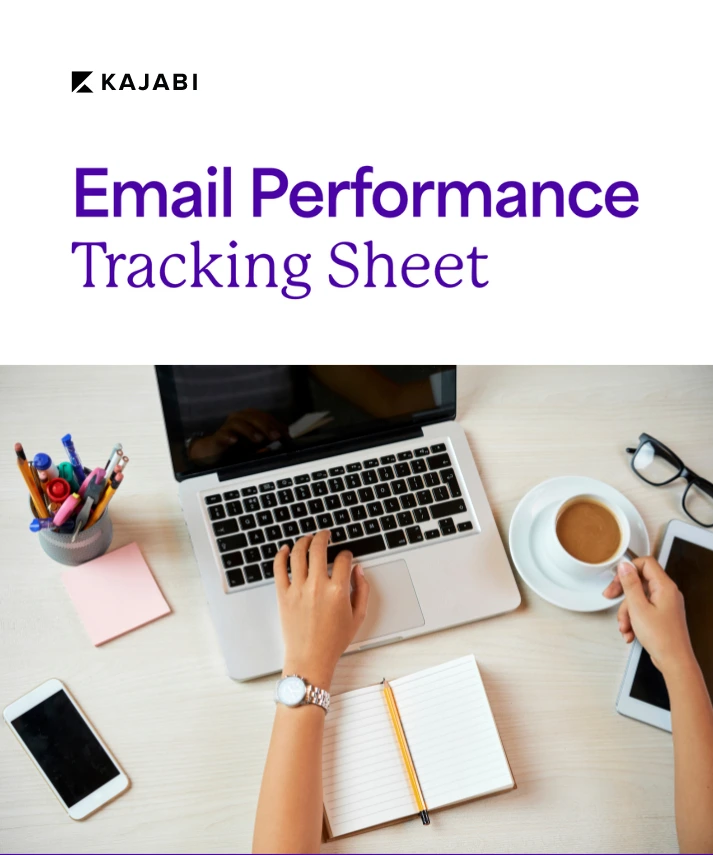
Simple and powerful email personalization tactics to up your marketing game
Get free expert insights and tips to grow your knowledge business sent right to your inbox.
Personalization is one of the most important marketing tools. It can dramatically strengthen the relationship between you and your customers, and it can help improve your metrics across the board. This is especially true when it comes to email marketing. Just look at the response rates from personalized email:
- 82% of marketers report an increase in open rates with email personalization (Instapage)
- Birthday emails generate 342% higher revenue per email than promotional emails. (Experian)
Email personalization can help improve open rates and deliverability. But personalization by itself isn’t a magic solution. In fact, if you personalize emails without creating real value, your marketing will suck.
You can’t just slap your customer’s name onto an email and call it a day. You have to be intentional with each detail. You want to sound like a human and not a creepy robot.
Whether you want to sell a coaching service, share your expertise, or sell an online course, there is a right way to do personalization in email marketing.
Let’s go over how to use email personalization to make your customers feel valued.
Personalized email marketing: the most underrated tool for marketers
There’s a huge gap between theory and practice when it comes to personalization. You can find hundreds of resources on email personalization, including endless stats that show a direct correlation between personalization and revenue. Thanks to email software, it’s easier than ever to add personalization in all kinds of ways.
Yet you’ll see emails from multimillion-dollar corporations that use zero personalization.
And this happens a lot. Look through your own emails. You’re sure to find way more non-personalized emails than personalized ones. You might find a couple that have personalized subject lines or introductory text, but you probably won’t find many that feel authentically personal.
So, what’s the deal?
It’s not that these major companies don’t have the information necessary to create a personalized email experience. We’re living in a time with unprecedented access to data and preferences. The tools exist, but companies are just ignoring it.
Email personalization is simply not considered a priority, and that needs to change.
Marketing is no longer about selling to people; it’s about connecting people to products and services that will genuinely improve their lives in some way. Customers need to know that a company values them and knows exactly what they need.
The second that we feel like just another name on a list, we’re out. Customers want to stay with brands who will appreciate not only their money, but also their support and attention.

Email personalization is one of the best ways to build those connections.
Email marketing alone can generate some ridiculous results. One study from the Direct Marketing Association reports an average ROI of $38 for every $1 spent.
Personalization boosts those numbers even more. For example, a study by Experian found that personalized subject lines had a 26% increase in unique open rates.

And in some industries, that number was even higher.

The truth is, customers aren’t giving companies their full attention. They are always consuming information and media, filtering through dozens of messages every minute. Unless a company goes out of its way to prove they care, the customer will move on to the next email.
Personalization in email marketing should work to make sure your customers know they’re valued. Keep reading to learn how to master this impactful technique.
Five Easy Ways to Use Personalization in Your Email Marketing
First, you need to understand some basic tenets of email personalization. Ultimately, it comes down to bringing humanity back into your marketing.
Is it something you’d want to read? Do you sound like you’re really offering value or just yelling into a void?
We’ll help you understand the difference and give you some guidelines to follow here.
1. Be clear about who you’re emailing and why: don’t be fake or forced
The people on your email list aren’t stupid. They know when they’re looking at a canned email template even if their name is on it.
Consider this email:

Now, obviously this isn’t a real email, but countless emails like this do get sent out every day. Ask yourself: Would this fool you even for a second? It’s almost laughably bad. Why? Because this is literally just a canned response that uses the recipient’s first name.
It’s technically a personalized email but it’s a bad example because it’s incredibly vague and could apply to anyone with a LinkedIn profile.
This is not how you do email personalization. To say this feels forced is a giant understatement, but it proves the point. If personalization comes off as forced or fake, it won’t succeed.
The best way to avoid this rookie mistake is to take a second before you send an email. Think about the purpose of the email.
What value are you delivering? Why should people care? If you can’t answer those basic questions, no amount of personalization in the email will drive results.
When you’re clear about who should care and why, it’s much easier to add the kind of personalized details that compel people to read more, click through, and convert on your calls-to-action.
If you find that you’re just sending an email just because you think you should, go back to the drawing board. Build a strategy around actually taking care of your customers. Then, add the personalization into your emails.
2. Get to know your subscribers inside and out
Imagine you’re meeting someone for the first time and you need to give them a personal gift. The catch is that you know nothing about them.
Would you be able to give them a truly personalized gift? Of course not! So how can you send your subscribers truly personalized emails unless you know them?
That’s where data comes in. When it comes to personalization, data is your friend.

If you’re not taking full advantage of your data, you’re basically sabotaging your efforts. You can’t excel at personalization unless you really know your customers. And you can’t really know your customers without diving deep into data.
Pay attention to your audience demographics. Yes, it’s basic, but it’s more important than ever.

In order to even stand a chance of setting yourself apart from your competitors, you’ll need to use demographics to their maximum potential.
Start with all the standard demographics:
- Name
- Age
- Gender
- Location
- Education level
- Annual income
- Marital status
You can also use more advanced metrics, like where a customer is in the life cycle or what kind of things they search for.

Build on this foundation by learning about what your customers value. You can uncover this information in a number of ways. For one, you can look at additional metrics like past purchasing behavior.
But you should also look at psychographics.

Psychographics are metrics that give you more specific insights into who your customers are and why they do what they do. These include things like:
- Hobbies
- Interests
- Values/beliefs
- Lifestyle
- Personality
Psychographics are useful because they give you a deeper understanding of the people who comprise your audience. Instead of seeing your customers as numbers in a spreadsheet, you need to see them as real, unique people, and psychographics can help you visualize them in that way.
Ultimately, you need to use both demographics and psychographics in order to really understand your customers.

To set a strong foundation for email personalization, come up with a list of questions to ask your subscribers. These questions should provide information about their demographics and psychographics.
As you compile all this data, use it to segment your audience. Remember the key to effective marketing is abandoning the idea that you can be everything to everyone. The more specific you are about who needs each product, course or resource, the better return you’ll see.
Let’s say you have a new mini course on dog training to sell. You want to create a personalized email marketing campaign encouraging your list to sign up.
By sending out a survey, you found out that one segment of your audience only has pet cats. It’s likely that they will not acknowledge or appreciate a course offering for dog owners. By excluding that segment from your dog training mini course list, you can ensure you’re only sending emails to people who will actually find them valuable.

3. Create a buyer persona to help with personalization
You can also create buyer personas to provide better personalized emails.
Buyer personas put demographics and psychographics to real use by creating fictional customers who represent real people in your user base.

Personas can go a long way toward connecting with your customers, and that means you’ll be able to more effectively personalize the emails you send them.
To create the most effective personas, think less about information and more about motivations. Look for data that speaks to why they do what they do. When creating a buyer persona, ask questions like:
- What do your subscribers think is most important about your company?
- What drives them towards action?
- Who do they want to be and how can they use your products to get there?
By focusing on motivations and values, you’ll have an easier time finding the right data to use in your personalized email marketing. You won’t waste time talking about their profession, for example, when you know they’re motivated by personality traits.
4. Email personalization is more than adding a name
The more effort you put into email marketing personalization, the better returns you’ll see.
If you add the recipient’s first name to your email template and call it a day, you’re not going to see great results. True personalization involves using relevant data to deliver targeted content that the user will love.
Remember that hilariously bad email sent to “Joe” up there? Here’s an example of how you can actually make that kind of email work:

This email uses targeted personalization and a more casual template. It uses both the recipient’s name and the name of their company. These two personalized elements and a strong call to action make for a more relevant and useful email for the recipient.
If you have the information available, consider adding these personalization elements to your next email:
- Customer’s last purchase
- Customer’s birthday
- Customer’s company name/industry
- Items the customer has put in their cart
- Items the customer has marked as “favorites”
- Customer’s city or state of residence
Personalized emails prove two vital things. The first is you respect your audience’s inbox. You don’t send every thought you have to every person on your list. You are intentional and mean it when you say you believe they’ll love this new offering you have.
The second is that you’re making use of all the information you collect from your audience. Think about the last white paper you downloaded. You likely gave information about your job title or another personal detail before you were granted access to the resource.
What happened to that information? Were you delivered highly targeted, personalized emails that made you feel understood? Or did you feel like you answered a bunch of questions that were all promptly ignored?
If you have those frustrations, so does your audience. People are happy to provide more information about their preferences and needs, but only if you prove that you use it in a meaningful way. If that information isn’t converted into more personalized email marketing messages, or better offerings in general, people are going to lose faith in the value you’re providing.
Take a look at the information below to understand what personalization features in emails resonate with audiences and what they’re thinking with each personalized detail you include.

Putting it all together for email personalization
Let’s take a look at what we’ve gone over so far:
- Personalization needs to be prioritized in your email marketing.
- Only send emails that deliver real value to your subscribers. Don't just send emails because you're trying to make a sale.
- Email personalization is more than using a name.
- Leverage demographics, psychographics, and buyer personas to learn more about your customers so you can deliver meaningful and personalized content.
So, now that you know what to do, let’s take a look at what NOT to do in email personalization.
Examples of bad email personalization
Everyone has seen horrible examples of email personalization before. Sometimes, it’s clear that zero effort was put into it. One obvious example is the “Hi, [First Name]” fail where the recipient sees the first name field instead of their actual name.
In this example, it’s an “Fname” fail.

Now that’s obviously a careless oversight, and it’s honestly a little funny. After all, everyone makes business mistakes.
But not all personalization blunders are so light-hearted.
For instance, in 2017, Amazon mistakenly sent out baby registry emails to thousands of people who weren’t parents, prompting a lot of confusion.

Even worse, some of the recipients had experienced fertility problems, so you can imagine how they must have felt when they saw that email.

The lesson is clear. From logistics to content, you need to make absolutely sure that you’re sending out the right email to the right people. In other words, don’t take personalization too lightly.
Personalization is a powerful tool, and that means it’s powerful when it’s used badly. Bad personalization can kill entire marketing campaigns. But good personalization can help you get some big wins.
To protect yourself, take the extra step to test each email send. Keep an eye out for how the personalized tokens will show up for people who haven’t given their information.
For example, what happens if someone in your list hasn’t provided their last name, but you include the personalization field in the email copy? It’s your responsibility to solve those issues so the reader gets the best possible reading experience when your email shows up.
Start improving your email marketing with personalization
You’ve probably picked up on this by now, but there’s a recurring theme here: The only way to effectively personalize your emails is to know your customers well.
Now, talking about how to get to know your audience is an article all by itself, so for now, keep a few things in mind:
- Use your data: Dig deep into your analytics and figure out what your customers love and what their values are.
- Send a survey: Find out as much as you can about your subscribers’ demographics and psychographics.
- Keep in touch with your customers: Be responsive on social media, ask for feedback, email subscribers individually––anything that connects you closely with your customers is good.
Personalization is much more than just a name. It’s a methodology that requires you to mold your content around your customers. If you want your customers to feel valued, you have to value them, and that means getting to know them and personalizing your emails based on what they want to see.
Once you’re ready to put these personalization skills into action, you’ll want to use an email platform that prioritizes personalization the same way you do. Kajabi can help by offering tons of flexible email personalization options all in one convenient place.
Check out our demo to see what else Kajabi can do for you.













